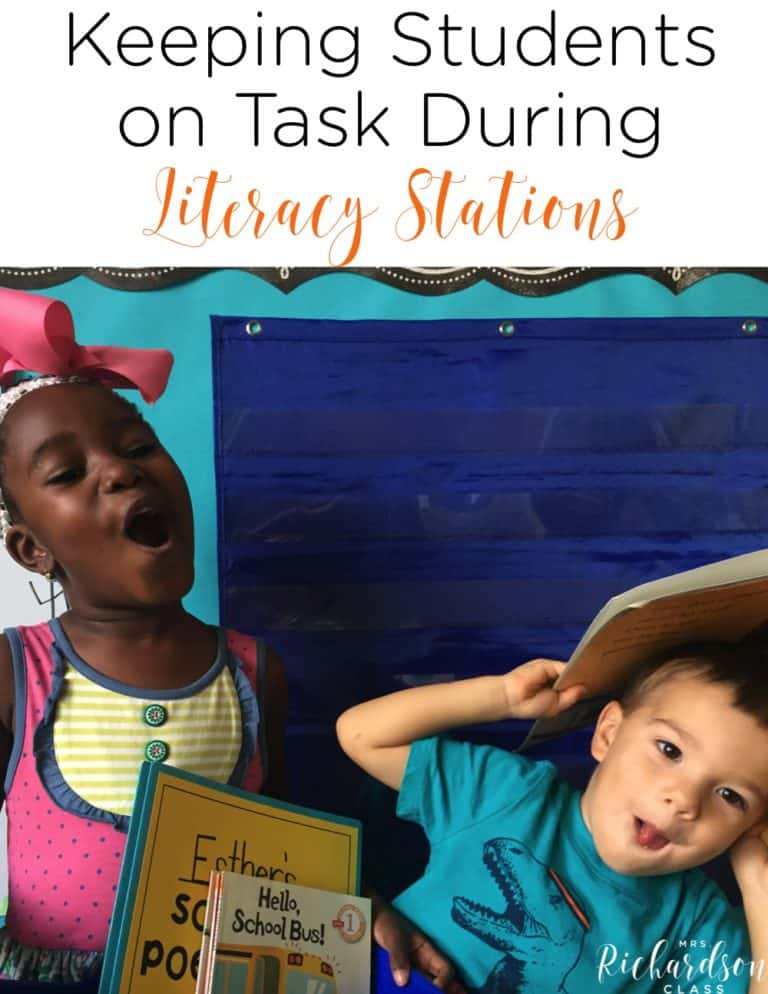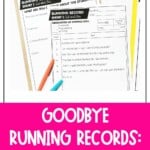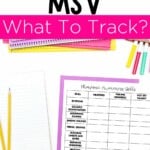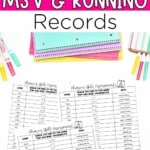


If you’re letting go of running records or wondering if they’re the best thing for your readers, but aren’t sure where to start, you are not alone, friend! Many of us have used running records and the MSV three-cueing system in our reading small groups. If you’re like me, I took many running records on each student, analyzed the data, and then targeted my reading group instruction based on the results.
Now, this might not sound like a bad plan on the surface, but then why do so many students still struggle to learn how to read? Why do some students fall further behind despite targeted reading small group instruction? Because there is a better way! The science of reading is teaching us that our readers need better assessments than running records. Letting go of running records as we previously used them is a big step in the right direction.
There are a few problems with running records. The science of reading research has shown us that they aren’t an effective measurement of reading success. Running records measure how readers use meaning, syntax or structure, and visual cues (MSV) while reading. However, here’s what research tells us:
“Novice readers need to focus on matching sounds to letters and sequences of letters so that they can literally identify words and begin to store them in their brain for instantaneous retrieval, i.e. “map” them orthographically.”
– Breaking the Code
So running records that rely on the three-cueing system don’t measure the skills we need our students to learn. The science of reading has taught us that students need explicit and systematic phonics instruction. Running records tend to treat phonics instruction as the last resort instead of the most important starting place.
The three-cueing system pulls our reader’s attention away from the sequence of letters in a word and relies very heavily on context clues and meaning to solve a word. Meaning and context clues can help our readers with simple, patterned books, but relying heavily on this strategy will fail them as they progress in reading.
If running records aren’t an effective way to measure the success of reading, what now? I’ve got a few ways you can assess students’ reading skills that are aligned with the science of reading and will help you know how to best support your readers.
Phonemic awareness is the foundation of teaching a child to read. Their reading readiness is built by doing phonemic awareness activities and working on concepts about print. With the science of reading research, we know that mastering phonemic awareness leads to stronger decoding skills.
Closely track students’ phonics skills and how they progress in their abilities. We want to see how they read and solve words with blends, digraphs, vowel teams, etc. This will show you exactly what skill they may need more support with. This also will give you a good place to begin with decodable readers. One thing to be sure of is that your decodable readers are aligned to the phonics progression you are following.
I have these phonemic awareness skills and phonics skills assessments in my FREE Reading Teacher Toolkit. You can download it by dropping your name and email address below!
As teachers, we still need documentation and tools for data tracking in reading. The tool “running records” as we know them isn’t effective, but we can rethink and rework our reading record forms into something that does. I revamped my running record forms to reflect the phonics skill that my students were working on. We need to monitor what matters most and that’s a student’s decoding ability!
If my reading small group is working on the “ay” vowel team, then we’ll read a decodable book or passage for “ay” vowel teams. Then I’ll take a running record on a student and record my observations while I’m looking for mastery of that phonics skill. (All of my decodable readers kits have this form included!)
One tool I love for monitoring student progress is dictation sentences. Once students have learned a new phonics skill in reading, we shift to writing with the phonics skills. Encoding skills go hand-in-hand with decoding skills. We are looking for the skill to come through in their writing to see that it really is cemented in their learning.
Ready to ditch running records and the three-cueing system? Then consider using decodable books and passages. Decodable readers provide students with an opportunity to explicitly practice the phonics skill they learned or the one they are working on. A good set of decodable readers should follow a progression, just like your phonics instruction does.
Giving students extra practice with authentic resources will help there be fewer gaps in their reading instruction. When students have multiple opportunities for practice, we know they usually get it a little quicker, than when they don’t have many opportunities to practice. Using decodable readers could help students close gaps in their reading skills and phonics instruction.
I have decodable books and passages with everything you need for reading small group lessons. First, each kit has a decodable book for each phonics skill covered in the kit. The books come in a printable color and black and white format, digital format, and passage format. Each book has a high decodability rate, is comprehensive, and follows a scope and sequence.
Each decodable reader kit also has tools for you like organizational labels, teaching posters, word work practice, and phonics skill practice for each lesson.
Additionally, each book also has a parent communication note. You can send the book home with the note so parents can read with their child. Then, parents will have some prompts to try if they get stuck and comprehension questions to ask them.
Grab the sets you need and get started reaching every reader in your classroom!
Short Vowels Decodable Readers
Open Syllables (Single Syllable) Decodable Readers
Open Syllable (Multisyllabic) Decodable Readers
If you are required to do running records by your school or district, by all means, do them! You can complete running records to give them what they want, but focus more on the reading assessments that will actually help you guide your readers. You use that part to guide your instruction!
If you use leveled books and are looking for lessons that align with the science of reading as much as possible, I can help with those, too! My Leveled Guided Reading Kits have leveled texts, teaching posters with science of reading aligned strategies, scripted lesson plans, running records, word work activities, parent involvement notes, and more!
Shop Kindergarten Guided Reading Lessons
Shop First Grade Guided Reading Lessons
Shop Second Grade Guided Reading Lessons
Change is hard, friend. Several years ago I had to shift my thinking once I saw the research and the benefits of making the change. But change can also be good. In this case, it will be great for your readers! So let go of the old running record and welcome in new ways to assess your readers!
Pin It!

Want to use the latest research to boost your readers during small groups? This FREE guide is packed with engaging ideas to help them grow!

I’m a K-1 teacher who is passionate about making lessons your students love and that are easy to implement for teachers. Helping teachers like you navigate their way through their literacy block brings me great joy. I am a lifelong learner who loves staying on top of current literacy learning and practices. Here, you’ll find the tools you need to move your K-2 students forward!


| Cookie | Duration | Description |
|---|---|---|
| cookielawinfo-checkbox-analytics | 11 months | This cookie is set by GDPR Cookie Consent plugin. The cookie is used to store the user consent for the cookies in the category "Analytics". |
| cookielawinfo-checkbox-functional | 11 months | The cookie is set by GDPR cookie consent to record the user consent for the cookies in the category "Functional". |
| cookielawinfo-checkbox-necessary | 11 months | This cookie is set by GDPR Cookie Consent plugin. The cookies is used to store the user consent for the cookies in the category "Necessary". |
| cookielawinfo-checkbox-others | 11 months | This cookie is set by GDPR Cookie Consent plugin. The cookie is used to store the user consent for the cookies in the category "Other. |
| cookielawinfo-checkbox-performance | 11 months | This cookie is set by GDPR Cookie Consent plugin. The cookie is used to store the user consent for the cookies in the category "Performance". |
| viewed_cookie_policy | 11 months | The cookie is set by the GDPR Cookie Consent plugin and is used to store whether or not user has consented to the use of cookies. It does not store any personal data. |



3 Responses
Hello! Is there somewhere we could see samples of the text for the levels? Also, how would you compare or how did you decide which skills should be in each level? Did you use a scope and sequence for phonic skills per level as well as sight words? Are first graders supposed to be able to read to Level J by the end of the year in your texts? My first grade team would love something for our reporting that shows which skills should be known per marking period. We had been using F & P (at grade level for first marking period was Level D, 2nd was Level F, 3rd was Level H, 4th was Level J ).
Jenni!! I’m so sorry I missed this comment! Yes, we can send you a few things to help. Email us at [email protected]
I would also like to receive scope and sequence if you have one readily available.